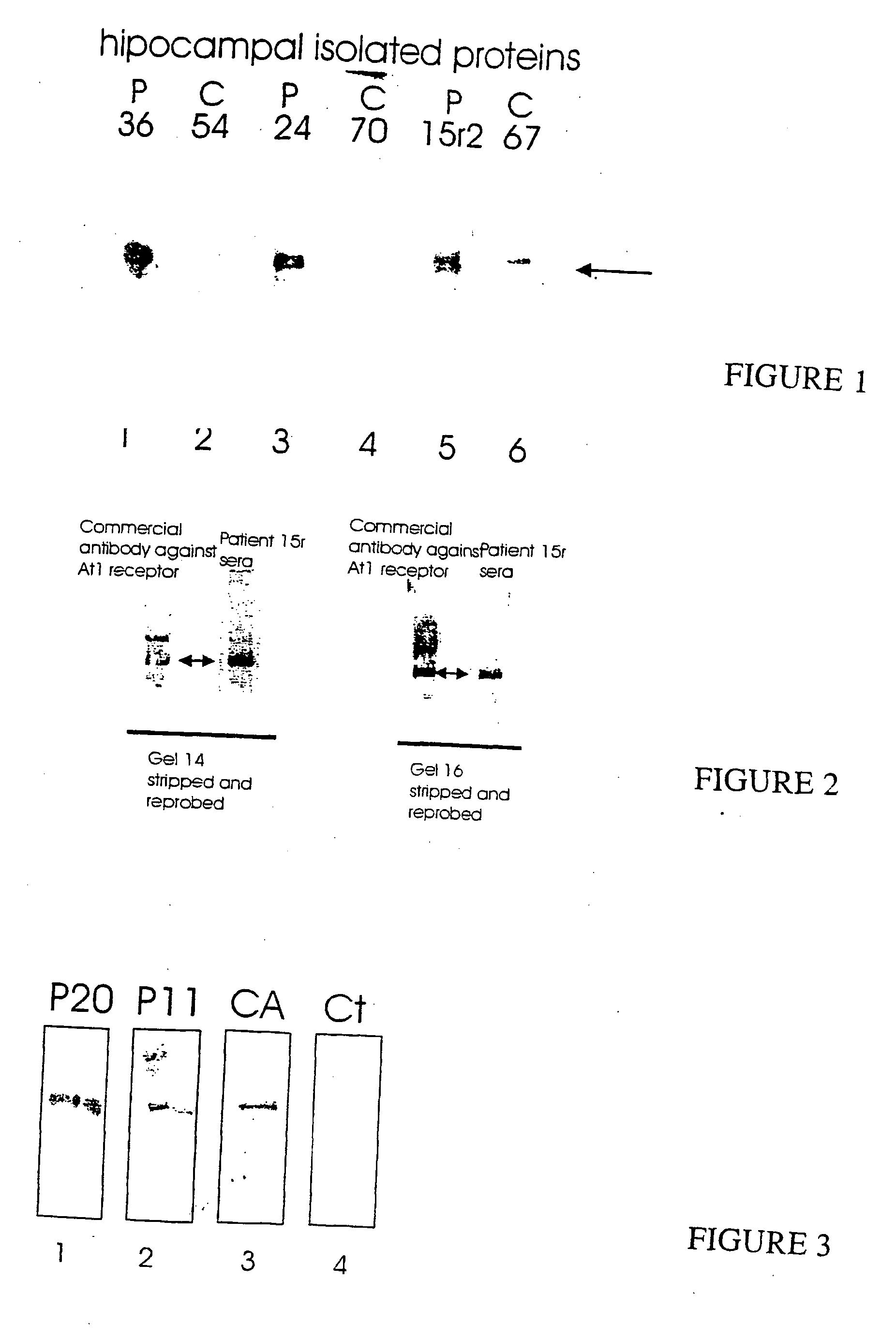Autoimmunity to angiotensin at1 receptors in schizophrenia
an angiotensin at1 receptor and autoantibodies technology, applied in the field of autoantibodies in schizophrenia, can solve the problems of time-consuming and laborious current methods for diagnosing schizophrenia, and the inability to adapt to widespread screening, so as to achieve rapid screening for schizophrenia and accurate and sensitive detection of autoantibodies
- Summary
- Abstract
- Description
- Claims
- Application Information
AI Technical Summary
Benefits of technology
Problems solved by technology
Method used
Image
Examples
example 1
Autoantibodies
[0036] Serum samples were obtained from 40 schizophrenic patients and 40 age and sex matched controls. The serum fractions were obtained from Foothills Hospital, Calgary, Alberta using standard techniques.
example 2
Preparation of Brain Antigens
[0037] Glycoproteins from human brain were obtained according to the following protocol. [0038] 1. Harvest rat / human hippocampus or other brain tissue and freeze immediately on dry ice. [0039] 2. Prepare Con-A-Sepharose beads: [0040] A. Wash 2.0 ml of beads with [0041] 10 mM MgCi2 / 10 mM MnCl2 (50 ml) [0042] 5% methyl-2-D-gucopyranoside in dH2O (50 ml) [0043] 0.1% SDS in 0.1 M Na Phosphate buffer pH 7.0 (50 ml) [0044] B. Resuspend@1:1 (V / v) in 0.1% (W / v) SDS in 0.1 M Na Phosphate buffer [0045] 3. Homogenize tissue in 0.32 M sucrose with [0046] 0.1 mM sodium orthovanadate [0047] 0.1 mM phenylmethylsulfonylfluoride (PMSF) [0048] 5 μg antipain [0049] 5 μg aprotinin [0050] 5 μg leupeptin [0051] Use 250 ml of solution and sonicate on ice. [0052] 4. Quantitate sample using a spectrophotometer [0053] 5. Add enough SDS to bring the concentration up to 1% SDS and boil 5 min. [0054] (12.5 ml 20% SDS in 250 ml) [0055] 6. Add dH2O to return concentration to 0.1% SDS...
example 3
Western Blot Analysis
[0069] The glycoproteins prepared according to Example 2 were separated by SDS-polyacrylamide gel electrophoresis using 7.5% polyacrylamide gels. Western blots were performed according to the following protocol: [0070] 1. 7.5% gel—run proteins@85 mA ˜2hrs [0071] 2. Transfer onto nitrocellulose or PVDF membrane overnight@30V or 1 hour@100V [0072] 3. Block 2 h 5% milk in TTBS Room temp. [0073] 4. Incubate with 1° antibody (serum diluted 1:100 or 1:200) one hour room temp. [0074] 5. Wash 3×5′ TTBS [0075] 6. Incubate with 20 reagent one hour RT [0076] 7. Wash 4×5′ TTBS [0077] 8. Incubate with substrate 5′[0078] 9. Rinse quickly in ddH2O [0079] 10. Wrap in Saran wrap and expose to film.
[0080] The following reagents were used:
TBS -Tris 10 mMAlternate Block -0.1% Tween 20NaCl 140 mM0.5% NP-40pH to 7.4*3.0% BSA in PBSddH2O to 1 L*fatty acid free BSATTBS -TBS 1 LSubstrate -Lumilight plusTween 20 1 ml(Roche)
[0081] The majority of patients with schizophrenia, greater t...
PUM
| Property | Measurement | Unit |
|---|---|---|
| molecular weight | aaaaa | aaaaa |
| molecular weight | aaaaa | aaaaa |
| reactivity | aaaaa | aaaaa |
Abstract
Description
Claims
Application Information
 Login to View More
Login to View More - R&D
- Intellectual Property
- Life Sciences
- Materials
- Tech Scout
- Unparalleled Data Quality
- Higher Quality Content
- 60% Fewer Hallucinations
Browse by: Latest US Patents, China's latest patents, Technical Efficacy Thesaurus, Application Domain, Technology Topic, Popular Technical Reports.
© 2025 PatSnap. All rights reserved.Legal|Privacy policy|Modern Slavery Act Transparency Statement|Sitemap|About US| Contact US: help@patsnap.com

